Here they are:
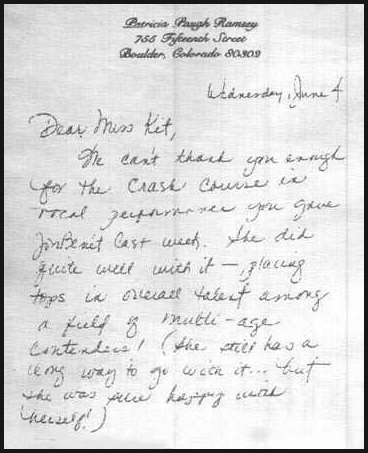
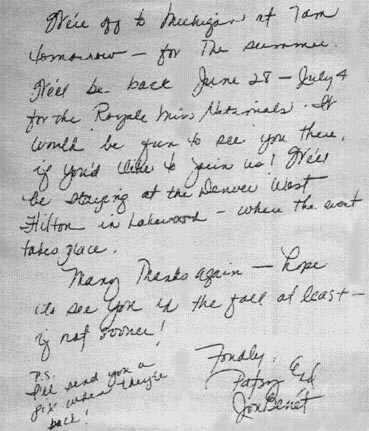
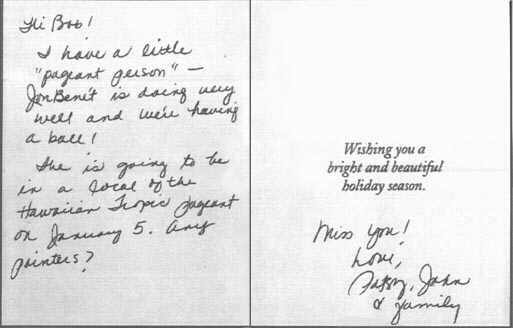
All that's missing here are two additional exemplars with very brief texts, apparently taken from a photo album: "I was 1½ I'm having a picture taken." And "I was 2. 1 was going bike riding with my Mom and my Dad".
On the basis of these examples, Wong concluded as follows:
Any of these observations will not be able to stand alone as evidence, but it is as a "collective whole" they represent a repetitive pattern which not only exists in the QD but also in the examined exemplars alleged written by Patsy Ramsey. Based upon preliminary analysis of these items, and from an application of forensic document examination principles and techniques, it is my professional opinion, that the hand that authored the known Standards for Comparison as Patsy Ramsey appears to be very likely the same hand that authored the Questioned Document "Ransom Note".I'm not aware of the complete history of Wong's relation with Darnay Hoffman and her research as a whole on this project, but it seems obvious the alphabetical comparisons must date from a later time, when she had more exemplars at her disposal. In this initial report, however, it would seem she had very little indeed to go on, especially considering that the first three examples are written in longhand, and the remaining ones consist of only a few words each. It's notable also that none of the exemplars has an overall look remotely resembling anything in the note.
You'll be relieved to learn that I'm not planning on reviewing her report in any detail (feel free to do that yourself, if you like), but I can't resist quoting this one bit: "*The left margin slowly pulls leftward towards the base of the page in Si and S2, which closely match the margins in the QD." She is referring to the tendency of the margins in the first three longhand pages reproduced above to drift to the left -- and yes, margin drift is definitely a feature of Patsy's writing style. However, the margins of the Questioned Document, i.e., the "ransom" note, do NOT drift at all, but adhere closely to the margins printed on the notepad. I suspect Wong was misled by the xerox copy sent to her by Darnay Hoffman, which may have been crooked.
What seems clearly apparent in both her initial report and the alphabetical comparison considered in my previous post, is a phenomenon well known to scientific researchers, usually referred to, colloquially, as cherry picking. If you are already convinced of a certain outcome ahead of time, then there is a very dangerous tendency to look for that outcome when doing your research and/or testing, and ignoring anything that doesn't fit. This syndrome is clearly apparent in her observation regarding margin drift, clearly an example of seeing what one wants to see.
Wong's alphabetical comparisons are presented as similarities, and often referred to more precisely as "matches," and yet many pairs show very little similarity at all. Others are generic, i.e., similar in ways one might expect to find among a great many people who write in more or less the same general manner. I counted only 6 similarities based on what looked to me like distinctive letter forms -- the rest struck me as generic.
Yet for her, as for so many others, the entire list is perceived as a list of matches between the ransom note and Patsy's hand. Well, OK, if you want to see them that way fine. But then what about all the many other exemplars not included in her comparison, those that very clearly do not match, by anyone's standards? Where are they? Interestingly, the more examples one has access to the more likely it is that similarities of one sort or another are going to be found. Thus, paradoxical as it may seem, the larger your sampling the more likely you are to find "matches," regardless of whether your suspect actually wrote the document or not. The more the merrier, one could say, because the more possibilities for a "match," the more "matches" you are likely to find, so if you really want to put someone away regardless of whether he or she is actually guilty of anything all you need to do is find more and more samples. Sooner or later you are sure to find something you can use. Of course you are also more likely to find mismatches, but if you are cherry picking, then that's just a bore -- ignore them.
So. Sorry folks, but what Cina Wang was doing was not science. First of all she is clearly cherry picking as she never presents any counter examples in the form of letters or words that are clearly and distinctively different, but looks only for similarities. Secondly, she presents no standard on which to decide whether any two exemplars are "similar" or "different." We can assume that no two are going to be exactly the same, so where do we draw the line? And how do we make sure we do that consistently, so every comparison is based on the same criteria? Finally, she never seems to take into consideration that the printing of the note was done in a deliberately deceptive manner, which means we can assume there will be both similarities and differences between the Questioned Document and the writing style of the individual who wrote it. Which means it may be extremely difficult if not impossible to either identify the writer or rule him out solely on the basis of forensic doc. analysis.
There is another problem as well: the lack of scientific control. Typical law enforcement procedure when asking a witness to identify a suspect is to put together a "lineup," consisting of the subject surrounded by several individuals who resemble him. If the witness can pick the suspect out of such a lineup, that is considered significant and the suspect may well be booked. A control of this sort is absolutely necessary in cases such as this, where identifying similarities and differences may not be sufficient in the face of deliberate deception -- and the possibility of investigator bias is always very real. The only truly scientific way to proceed in such a case would be to compile a control group of documents from several different sources, with roughly similar writing styles to that of the suspect, in addition to documents written by the suspect, for comparison with the questioned document -- roughly equivalent to a lineup. Then forensic document specialists would be asked to compare each of these with the questioned document, only with no knowledge of who wrote what. If they can arrive at a consensus regarding the identity of the writer in a controlled environment such as this, then their result can be considered meaningful, and, as with the lineup, the individual in question must be taken seriously as a suspect.
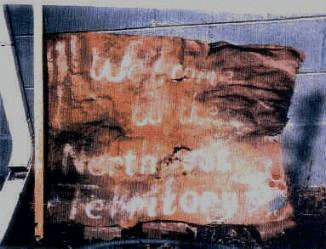
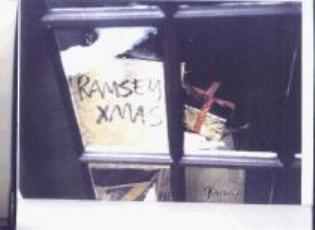
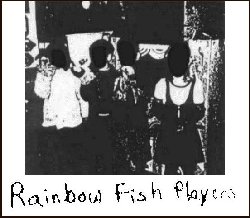
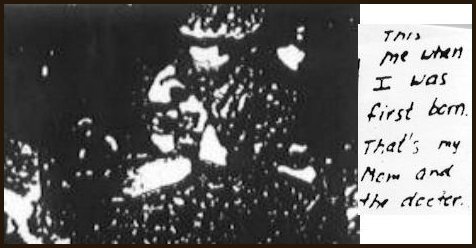
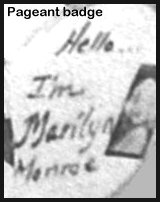
Here's what I think happened. If John was the initial
ReplyDeletemain suspect, I think Patsy too started getting suspicious. I'm sure John knew as well that they were looking very closely at him and his actions. He needed an out. Desperately. So he made sure that the finger was pointed at Patsy when it came to the handwriting, who he knew was innocent. Because this served two purposes for him. One: the police were no longer suspicious of him. Two: Patsy would be forced to lose trust in the police. If they were pointing the finger at her and she knew that she was innocent, then maybe John was innocent too. It quickly looked like the police were clueless and pointing fingers. Which clearly worked in John's favor. I'm not sure how he paid them off or what he had to offer them, but he was an intelligent businessman and probably thought of something. And it obviously worked.
We have no way of knowing what went on as the investigation proceeded. We DO know John and his legal team hired their own handwriting "experts" within a week or so and these people very quickly decided to rule John out. But were unable to do so for Patsy. So maybe you have a point. Were they bought off, or was the influence purely psychological? Again we have no way of knowing, but how many murder suspects do you know of who were permitted to conduct their own investigation of their own case?
DeleteNot to veer too far off subject, but what happened to your thread "Did John Write This" on Websleuths?
ReplyDeleteGood question. I noticed that too. I think someone with some influence over there decided he'd made too much of a fool of himself and needed all evidence of his folly flushed down the toilet (where it belongs, if you get my drift).
DeleteThat's one reason I decided to blog, so I could express my opinions without fear of censorship. I feel bad, however, for others who took precious time to post on that thread to nowhere.